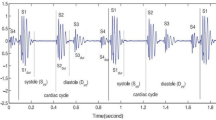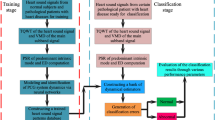Abstract
Auscultation is an important diagnostic indicator for cardiovascular analysis. Heart sound classification and analysis play an important role in the auscultative diagnosis. This study uses a combination of Mel-frequency cepstral coefficient (MFCC) and hidden Markov model (HMM) to efficiently extract the features for pre-processed heart sound cycles for the purpose of classification. A system was developed for the interpretation of heart sounds acquired by phonocardiography using pattern recognition. The task of feature extraction was performed using three methods: time-domain feature, short-time Fourier transforms (STFT) and MFCC. The performances of these feature extraction methods were then compared. The results demonstrated that the proposed method using MFCC yielded improved interpretative information. Following the feature extraction, an automatic classification process was performed using HMM. Satisfactory classification results (sensitivity ≥0.952; specificity ≥0.953) were achieved for normal subjects and those with various murmur characteristics. These results were based on 1398 datasets obtained from 41 recruited subjects and downloaded from a public domain. Constituents characteristics of heart sounds were also evaluated using the proposed system. The findings herein suggest that the described system may have the potential to be used to assist doctors for a more objective diagnosis.





Similar content being viewed by others
References
Coast D. A., Cano G. G., Briller S. A. (1990) Use of hidden Markov models for electrocardiographic signal analysis. J. Electrocardiol. 23(Suppl):184–191
Coast D. A., Stern R. M., Cano G. G., Briller S. A. (1990) An approach to cardiac arrhythmia analysis using hidden Markov models. IEEE Trans. Biomed. Eng. 37:826–836
Criley, J. M., D. Criley, and C. Zalace. The physiological origins of heart sounds and murmurs: the unique interactive guide to cardiac diagnosis. Boston: Blaufuss Medical Multimedia, 1995
Debbal S. M., Bereksi-Reguig F. (2004) Analysis of the second heart sound using continuous wavelet transform. J. Med. Eng. Technol. 28:151–156
El-Segaier M., Lilja O., Lukkarinen S., Sornmo L., Sepponen R., Pesonen E. (2005) Computer-based detection and analysis of heart sound and murmur. Ann. Biomed. Eng. 33:937–942
Godino-Llorente J. I., Gomez-Vilda P. (2004) Automatic detection of voice impairments by means of short-term cepstral parameters and neural network based detectors. IEEE Trans. Biomed. Eng. 51:380–384
Guo Z., Durand L. G., Lee H. C., Allard L., Grenier M. C., Stein P. D. (1994) Artificial neural networks in computer-assisted classification of heart sounds in patients with porcine bioprosthetic valves. Med. Biol. Eng. Comput. 32: 311–316
Leatham A. Auscultation of the Heart and Phonocardiography, 2nd Edition. London: Churchill Livingstone, 1975
Li X., Parizeau M., Plamondon R. (2000) Training hidden Markov models with multiple observations-a combinatorial method. IEEE Trans. Pattern Anal. Mach. Intell. 22:371–377
Liang H., Lukkarinen S., Hartimo I. (1997) Heart sound segmentation algorithm based on heart sound envelogram. Comput. Cardiol. 24:105–108
Marcus G. M., Gerber I. L., McKeown B. H., Vessey J. C., Jordan M. V., Huddleston M., McCulloch C. E., Foster E., Chatterjee K., Michaels A. D. (2005) Association between phonocardiographic third and fourth heart sounds and objective measures of left ventricular function. JAMA 293:2238–2244
Michael T. A. D. (1997) Auscultation of the Heart. New York: McGraw-Hill
Nanda N. C. Doppler Echocardiography, 2nd Edition. London: Lea & Febiger, 1992
Rabiner L. R. (1989) A tutorial on hidden Markov models and selected applications in speech recognition. Proc. IEEE 77:257–286
Voss A., Mix A., Hubner T. (2005) Diagnosing aortic valve stenosis by parameter extraction of heart sound signals. Ann. Biomed. Eng. 33:1167–1174
Wu G-D., Lin C-T. (2000) Word boundary detection with mel-scale frequency bank in noisy environment. IEEE Trans. Speech Audio Process 8:541–554
Author information
Authors and Affiliations
Corresponding author
Rights and permissions
About this article
Cite this article
Wang, P., Lim, C.S., Chauhan, S. et al. Phonocardiographic Signal Analysis Method Using a Modified Hidden Markov Model. Ann Biomed Eng 35, 367–374 (2007). https://doi.org/10.1007/s10439-006-9232-3
Received:
Accepted:
Published:
Issue Date:
DOI: https://doi.org/10.1007/s10439-006-9232-3




